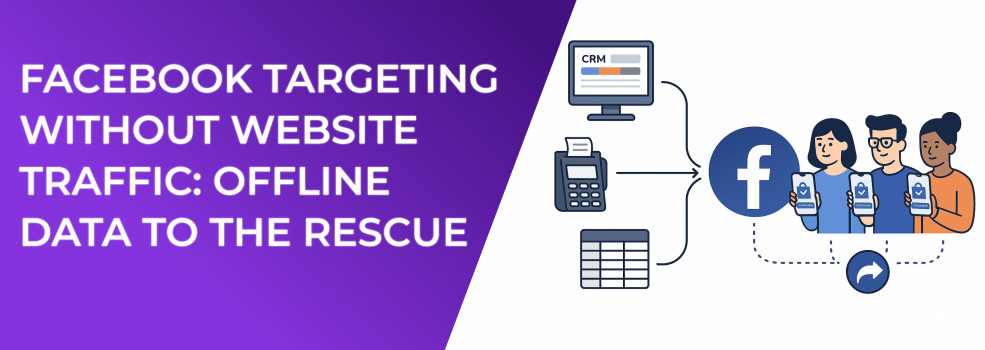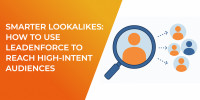If you have ever opened Ads Manager, stared at Pixel Events = 0, and worried about your Facebook ad performance benchmarks, take heart. You can still hit a healthy average conversion rate on Facebook, even when no one is visiting your site. The secret lies in the customer, subscriber, and point-of-sale records you already own. Feed those offline signals into Meta and watch them power fresh, high-intent audiences, boost ad impressions, and keep campaign budget optimization humming without a single new page‑view.
1. Why Offline Data Beats Guess‑and‑Check Targeting
Facebook’s delivery system runs on probabilities. With only a handful of pixel fires, campaigns get stuck in the learning phase, spend cautiously, and never reach scale. Uploading offline conversions lets you drop hundreds of verified purchases into the algorithm in one shot. More signals mean faster exits from learning, lower cost per result, and stronger ROAS. If you suspect the algorithm is dragging its feet, our step‑by‑step guide on how to finish the Facebook learning phase quickly shows exactly how to speed things up.
Because Meta can finally see which segments actually swipe cards, Advantage Campaign Budget becomes a smart, not blind, setting. You also gain clear revenue tracking in Events Manager, turning vague link‑click metrics into concrete sales numbers.
2. Prepare Your File Like a Pro
Before opening Offline Events Manager, make sure your CSV is squeaky‑clean. A tidy file boosts match rates, which directly improves Custom Audience quality.
Aim for a match rate of 90 percent or higher. Save the sheet as UTF‑8 CSV and you’re ready to upload.
3. Upload, Map, and Match in Offline Events Manager
Need a refresher on objectives? See our breakdown of Meta ad campaign objectives and when to use each one.
Create a pixel in Facebook (even if it never fires on‑site).
Open Events Manager → Data Sources → Offline, click Upload Offline Events, and map each column.
Wait for green check‑marks confirming a successful match.
When the event finishes processing, return to Ads Manager, choose the conversions objective, and optimize ad sets for your new offline‑purchase event. You should see steadier CPAs, healthier click‑through rates, and more confident spend ramps within days.
4. Build Audiences That Make Algorithms Drool
Offline data isn’t just for attribution; it’s rocket fuel for targeting. Test at least one of these audience formulas right away:
High‑value past buyers: Upload customers from the last 180 days with a lifetime‑value column so Meta can weight spend toward big spenders.
Subscription renewals: Segment active payers 30 days before renewal and show reminder ads to head off churn.
In‑store converts: Retailers can feed POS transactions and build lookalikes that never overlap with e‑commerce traffic.
Three offline segments that make algorithms drool.
Refresh the file weekly so new customers keep the learning phase short. For a deeper dive into targeting fundamentals, bookmark Facebook Ad Targeting 101: How to Reach the Right Audience. Not sure whether to rely on existing buyers or algorithm‑built twins? Our comparison of custom vs lookalike audiences can help you decide.
5. Creative and Messaging Tips That Feel Human
No one likes robotic ad copy. Use real‑world cues that resonate with past buyers:
Speak their language — reference loyalty points, SKU names, or store locations.
Show social proof — a small graphic comparing landing‑page views versus link clicks proves offline buyers don’t need a visit to convert.
Iterate deliberately — swap out images but keep the core message stable so you can see exactly what moves performance.
A/B testing these creative elements is essential to separating visual impact from messaging clarity.
6. Measure Success Without Pixel Fires
Open Ads Reporting and filter by your offline‑purchase event. When performance stalls, this checklist on Facebook ads not converting and how to fix it will walk you through the fastest diagnostics. Track cost per offline purchase, revenue per offline purchase, and offline ROAS, then compare those figures to on‑site stats. If CPAs stay low, push spend via Campaign Budget Optimization; if they drift upward, refresh creative or tighten bid caps before scaling again.
7. Common Pitfalls and Quick Fixes
Even the most buttoned‑up upload can hit a snag. Before you scroll, remember that a single formatting error can snowball into wasted ad spend. Treat each upload like a product launch: test, verify, iterate, and only then scale. Keep an eye out for the three issues below, and you’ll avoid 90 percent of troubleshooting headaches:
Make this table your desk‑side cheat‑sheet. The moment you notice a data‑quality alert or a sudden spike in CPA, revisit these three rows, correct the root cause, and give Meta 24‑48 hours to re‑optimize before changing budgets. Staying disciplined here preserves momentum and prevents costly guess‑and‑check cycles. If you ever see the dreaded “May Get Zero” warning, here’s why it happens and how to fix an ad set that may get zero impressions.
8. Final Thoughts
A barren pixel does not have to doom your ads. By putting offline data in the driver’s seat, you hand Meta exactly the proof it needs to deliver smarter traffic. That translates into higher click‑through rates, tighter CPCs, and revenue that lands in your bank account, even when your website is silent.
Ready to rescue your targeting and watch Facebook ad optimization go from theory to daily reality? The next move is yours.

